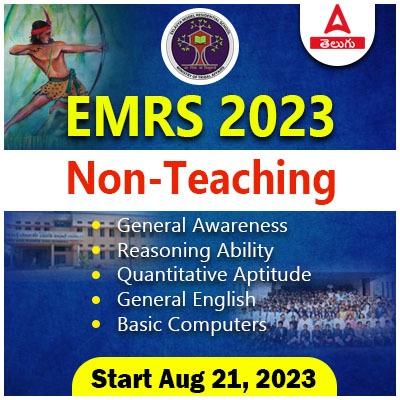
ఆంధ్రప్రదేశ్ మరియు తెలంగాణ లో అత్యంత ముఖ్యమైన మరియు ప్రతిష్టాత్మకమైన పరీక్షలు గ్రూప్-1,2,3 అలాగే UPSC లలోనికి చాలా మంది ఆశావహులు ఈ ప్రతిష్టాత్మక ఉద్యోగాల్లో కి ప్రవేశించడానికి ఆసక్తి చూపుతారు.దీనికి పోటీ ఎక్కువగా ఉండడం కారణంగా, అధిక వెయిటేజీ సంబంధిత సబ్జెక్టులను ఎంచుకుని స్మార్ట్ అధ్యయనంతో ఉద్యోగం పొందవచ్చు. ఈ పరీక్షలలో ముఖ్యమైన అంశాలు అయిన పౌర శాస్త్రం , చరిత్ర , భూగోళశాస్త్రం, ఆర్ధిక శాస్త్రం, సైన్సు మరియు విజ్ఞానం, సమకాలీన అంశాలు చాల ముఖ్యమైన పాత్ర పోషిస్తాయి. కాబట్టి Adda247, ఈ అంశాలకి సంబంధించిన కొన్ని ముఖ్యమైన ప్రశ్నలను మీకు ప్రతిరోజు క్విజ్ రూపంలో అందిస్తుంది. ఈ పరీక్షలపై ఆసక్తి ఉన్న అభ్యర్థులు దిగువ ఉన్న ప్రశ్నలను పరిశీలించండి.
ప్రశ్నలు
Q1. దిగువ ప్రకటనలను పరిగణనలోకి తీసుకోండి.
1. భారతదేశంలో ఏడు విభిన్న జాతుల అడవి పిల్లులకు నిలయంగా ఉన్న ఏకైక అభయారణ్యం ఇది.
2. ఇది ఆకురాల్చే వర్షారణ్యాలు ఉన్న ప్రాంతాలలో ఉంది, ఇది పాక్షిక సతతహరిత మరియు పచ్చని వృక్షజాలంతో ఉంటుంది.
3. ఇటీవల అస్సాం ప్రభుత్వం ఈ వన్యప్రాణి అభయారణ్యం జాతీయ ఉద్యానవనంగా అప్ గ్రేడ్ చేయాలని నిర్ణయించింది.
పై వాటిని గుర్తించండి:
(a) నంబోర్డోయిగ్రంగ్ వన్యప్రాణి అభయారణ్యం
(b) దేహింగ్ పాట్కై వన్యప్రాణి అభయారణ్యం
(c) భద్ర వన్యప్రాణి అభయారణ్యం
(d) చిన్నార్ వన్యప్రాణి అభయారణ్యం
Q2. “యునైటెడ్ ఫర్ బయోడైవర్శిటీ” సంకీర్ణం, కొన్నిసార్లు ఇటీవల వార్తల్లో కనిపిస్తుంది, దేనికి సంబంధించినది
(a) ఐక్యరాజ్యసమితి పర్యావరణ కార్యక్రమం
(b) యూరోపియన్ కమిషన్
(c) వాతావరణ మార్పులపై ఐక్యరాజ్యసమితి ముసాయిదా సమావేశం
(d) గ్లోబల్ ఎన్విరాన్ మెంట్ ఫెసిలిటీ
Q3. ఇటీవల జాతీయ చంబల్ అభయారణ్యం కేంద్ర ప్రభుత్వం పర్యావరణ సున్నితమైన జోన్ గా ప్రకటించింది. “జాతీయ చంబల్ అభయారణ్యం” భారతదేశంలోని ఈ క్రింది రాష్ట్రాలలో ఏ ప్రాంతాలలో ఉంది?
1. ఉత్తర ప్రదేశ్
2. మద్య ప్రదేశ్
3. మహారాష్త్ర
4. రాజస్తాన్
దిగువ నుంచి సరైన కోడ్ ఎంచుకోండి:
(a) 1, 2 మరియు 3
(b) 2, 3 మరియు 4
(c) 1, 2 మరియు 4
(d) 1, 2, 3 మరియు 4
Q4. కింది వాటిలో ఏది అతి పెద్ద సహజ భూసంబంధమైన కార్బన్ స్టోర్?
(a) మహా సముద్రం
(b) పీట్ ల్యాండ్స్
(c) ఉష్ణమండల అడవులు
(d) మడ అడవులు
Q5. సూన్య సాగుబడి వ్యవసాయం యొక్క లక్షణాలకు సంబంధించి దిగువ ప్రకటనలను పరిగణనలోకి తీసుకోండి.
1. పంట కాల వ్యవధి తగ్గుతుంది మరియు దీని ద్వారా పంట ముందస్తుగా వస్తుంది.
2. అవశేష తేమ కోల్పోవడం
3. సాగు ఖర్చు లో తగ్గుదల ఉంటుంది.
పైన ఇవ్వబడ్డ ప్రకటనల్లో ఏది సరైనది?
(a) 1 మరియు 2
(b) 2 మరియు 3
(c) 1 మరియు 3
(d) 1, 2 మరియు 3
Q6. జీరో బడ్జెట్ సహజ వ్యవసాయా ని (ZBNF)కి సంబంధించి ఈ క్రింది నిబంధనలను పరిశీలించండి.
1. జీవామృతం: నేల వాయువు
2. బీజామృతం: స్థానిక ఆవు పేడ మరియు ఆవు మూత్రాన్ని ఉపయోగించి విత్తన చికిత్స
3. వాఫాసా: స్థానిక ఆవు పేడతో చేసిన టీకాలు వేయడం
4. మల్చింగ్: మట్టిలో అనుకూలమైన సూక్ష్మ వాతావరణాన్ని ధృవీకరించే కార్యకలాపాలు
పైన ఇవ్వబడ్డ ప్రకటనల్లో ఏది సరైనది?
(a) 1, 2 మరియు 3
(b) 2, 3 మరియు 4
(c) 2 మరియు 3
(d) 1, 2, 3 మరియు 4
Q7. లంబ వ్యవసాయ వ్యవస్థలకు సంబంధించి ఈ క్రింది ప్రకటనలను పరిశీలించండి
1. ఇది ప్రధానంగా పట్టణ క్లస్టర్లలో ఆచరించబడుతుంది మరియు పట్టణ ప్రాంతాలను పచ్చగా మార్చడానికి మరియు నగరాల్లో వాయు కాలుష్యాన్ని తగ్గించడానికి దారితీస్తుంది.
2. ఈ సాగు విధానం వరదలు, భారీ వర్షాలు, అసమాన వర్షాలు వంటి ప్రకృతి యొక్క వగారీల ప్రమాదం లేకుండా సంవత్సరం పొడవునా ఆహారాన్ని ఉత్పత్తి చేస్తుంది.
3. పురుగు మందులు లేని లేదా సేంద్రియ ఆహారం ఉత్పత్తి చేయబడుతుంది
పైన ఇవ్వబడ్డ ప్రకటనల్లో ఏది సరైనది?
(a) 1 మరియు 2
(b) 2 మరియు 3
(c) 1 మరియు 3
(d) 1, 2 మరియు 3
Q8. దిగువ జతలను పరిగణనలోకి తీసుకోండి.
1. హైడ్రోపోనిక్స్: మట్టి లేకుండా నీటిలో మొక్కలను పెంచడం
2. ఏరోపోనిక్స్: పోషకాల ద్రావణం యొక్క పిచికారీ లేదా పొగమంచుతో మొక్కలను పెంచడం
3. ఆక్వాపోనిక్స్: పోషకాహార చేపల వ్యర్థాలలో మొక్కలను పెంచడం
పైన ఇవ్వబడ్డ ప్రకటనల్లో ఏది సరైనది?
(a) 1 మరియు 2
(b) 2 మరియు 3
(c) 1 మరియు 3
(d) 1, 2 మరియు 3
Q9. గ్రీన్ AG ప్రాజెక్ట్ కు సంబంధించి దిగువ ప్రకటనలను పరిగణనలోకి తీసుకోండి.
ఈ ప్రాజెక్టు ప్రధాన స్రవంతి జీవవైవిధ్యం, వాతావరణ మార్పు, మరియు స్థిరమైన భూ నిర్వహణ లక్ష్యాలు మరియు విధానాలను భారతీయ అటవీ లోకి తీసుకు రావడానికి ప్రయత్నిస్తుంది.
ఇది భారత ప్రభుత్వ సహకారంతో ఐక్యరాజ్యసమితి పర్యావరణ కార్యక్రమం ప్రారంభించిన ప్రాజెక్ట్.
పైన ఇవ్వబడ్డ ప్రకటనల్లో ఏది సరైనది?
(a) 1 మాత్రమే
(b) 2 మాత్రమే
(c) 1 మరియు 2 రెండూ
(d) 1 , 2 కాదు
Q10. ఈ క్రింది వాటిలో ఏది వ్యవసాయంలో నీటి సంరక్షణకు సహాయపడుతుంది?
1. భూమి యొక్క తక్కువ లేదా జీరో దున్నడం
2. పొలానికి సాగునీరు అందించడానికి ముందు జిప్సం అప్లై చేయడం
3. పంట అవశేషాలను పొలంలో ఉండటానికి అనుమతిస్తుంది.
దిగువ ఇవ్వబడిన కోడ్ ఉపయోగించి సరైన సమాధానాన్ని ఎంచుకోండి.:
(a) 1 మరియు 2 మాత్రమే
(b) 3 మాత్రమే
(c) 1 మరియు 3 మాత్రమే
(d) 1, 2 మరియు 3
ఆన్లైన్ లైవ్ క్లాసుల కొరకు ఇక్కడ క్లిక్ చేయండి
సమాధానాలు :
S1.Ans.(b)
Sol. The Assam government has decided to upgrade DehingPatkai Wildlife Sanctuary into a national park.
The announcement comes just months after the National Board of Wildlife’s (NBWL) conditional clearance to a coal mining project by Coal India Limited (CIL) in the DehingPatkai Elephant Reserve sparked a spate of virtual protests in the state.
Subsequently, North Eastern Coalfields (NEC), the CIL subsidiary, temporarily suspended all mining operations in the region.
• It is the only sanctuary in India that is home to seven different species of wildcats viz Tiger, leopard, clouded leopard, leopard cat, golden cat, jungled cat, marbled cat
• DehingPatkai is a deciduous rainforest interspersed with semi-evergreen and lush green flora, the only patch of virgin rainforest in Assam
• Dehing is the name of the river that flows through this forest and Patkai is the hill at the foot of which the sanctuary lies.
S2.Ans.(b)
Sol.The European Commission (EC) launched the ‘United for Biodiversity’ coalition made up of zoos, aquariums, botanical gardens, national parks, and natural history and science museums from around the world, on World Wildlife Day 2020
So, option (b) is correct
S3.Ans.(c)
Sol. National Chambal sanctuary has been declared as an eco-sensitive zone by the central government. The decision to declare the area as an eco-sensitive zone will prohibit the construction of hotels or resorts within an area of zero to two kilometers from the sanctuary, Formed to protect the Chambal river eco-system, the National Chambal Sanctuary, also known as the National Chambal Gharial Sanctuary, is famous for Ganges river dolphins, gharials (a crocodile variety native to India), mugger crocodiles and freshwater turtles.
• The sanctuary, in Uttar Pradesh, covers about 400 km of the Chambal river area, which starts from Rajasthan’s Kota barrage.
• It was declared a national sanctuary in 1979 and sits across three states: Madhya Pradesh, Uttar Pradesh, and Rajasthan.
• One can spot a diverse variety of birds here and over 290 species of migratory and resident birds have been identified so far.
• The main draw of the sanctuary is flamingos that arrive here in November and stay till May.
S4.Ans.(b)
Sol. Peatlands are the largest natural terrestrial carbon store; the area covered by near-natural
peatland worldwide (>3 million km2) sequesters 0.37 gigatonnes of carbon dioxide (CO2) a year storing more carbon than all other vegetation types in the world combined.
So option (b) is correct
S5.Ans.(d)
Sol. Tillage is an agricultural land preparation through mechanical agitation which includes digging, stirring, and overturning. Zero tillage is the process where the crop seed will be sown through drillers without prior land preparation and disturbing the soil where previous crop stubbles are present. Zero tillage not only reduces the cost of cultivation it also reduces the soil erosion, crop duration, and irrigation requirement, and weed effect which is better than tillage. Zero tillage (ZT) is also called No-Tillage or Nil Tillage.
The advantages of Zero tillage include:
• Reduction in the crop duration and thereby early cropping can be obtained to get higher yields.
• Reduction in the cost of inputs for land preparation and therefore a saving of around 80%.
• Residual moisture can be effectively utilized and the number of irrigations can be reduced.
• Dry matter and organic matter get added to the soil.
• Environmentally safe – Greenhouse effect will get reduced due to carbon sequestration.
• No-tillage reduces the compaction of the soil and reduces the water loss by runoff and prevents soil erosion.
• As the soil is intact and no disturbance is done, No-Till lands have more useful flora and fauna
S6.Ans.(c)
Sol. Zero Budget Natural Farming (ZBNF) :
• It is a natural farming technique in which farming is done without the use of chemicals and without using any credits or spending any money on purchased inputs.
• ZBNF reduces the cost of production down to zero due to the utilisation of all the natural resources available in and around the crops. Farmers use earthworms, cow dung, urine, plants, human excreta, and other biological fertilizers for crop protection.
The father of ZBNF and Padma Shri Awardee, Sh. Subash Palekar has provided four important non-negotiable guidelines:
1. Bijamrita (Seed Treatment using local cow dung and cow urine
2. Jiwamrita (applying inoculation made of local cow dung and cow urine without any fertilizers and pesticides)
3. Mulching (activities to ensure favorable microclimate in the soil), and
4. Waaphasa (soil aeration)
S7.Ans.(d)
Sol. Vertical farming is cultivating and producing crops/ plants in vertically stacked layers and vertically inclined surfaces. The entire world is on the verge of a population explosion and there is the gravest challenge of feeding the population.
Advantages of vertical farming
• The first and the major advantage of vertical farming is producing extremely high yields per available land or area.
• Producing the food throughout the year without the risk of vagaries of nature like floods, heavy rains, uneven rains, hail and snowfall, drought, dry spells, extreme high temperatures, cold waves, epidemics of pests and diseases, etc.
• It reduces the cost of transporting loads of food grains from a rural area to urban areas and reduce the spoilage occurring therein. Fossil fuel consumption in transporting the farm produce to cities from village places is also reduced to a greater extent. Vertical farming uses 70 to 95 % less water compared to traditional farming
• 90%less or no soil is needed in vertical farming and thereby no pest and disease infestations.
• Pesticide-free or organic food is produced as there is no use of pesticides.
• Due to the reduced food supply chain, consumers get fresh produce with all its original nutrient qualities.
• High productivity per unit area i.e. almost 80% more harvest per unit of area in vertical farming.
• It will lead to the greening of the urban areas and help to reduce the rising temperatures and mainly the air pollution in cities.
S8.Ans.(d)
Sol. Systems of Vertical farming
1. Hydroponics:
• It is a method of growing food in water using mineral nutrient solutions without soil. The basic advantage of this method is that it reduces soil-related cultivation problems like soil-borne insects, pests, and diseases.
2. Aeroponics
• In aeroponics, there is no growing medium and hence, no containers for growing crops. In
aeroponics, mist or nutrient solutions are used instead of water. As the plants are tied to support and roots are sprayed with nutrient solution, it requires very little space, very less water, and no soil.
3. Aquaponics
• It is a bio-system that integrates recirculated aquaculture (fish farming) with hydroponic vegetable, flower, and herb production to create symbiotic relationships between the plants and the fish.
• It achieves this symbiosis by using the nutrient-rich waste from fish tanks to “fertigate”
hydroponic production beds. In turn, the hydroponic beds also function as bio-filters that remove gases, acids, and chemicals, such as ammonia, nitrates, and phosphates, from the water.
• Simultaneously, the gravel beds provide habitats for nitrifying bacteria, which augment the
nutrient cycling and filter water. Consequently, the freshly cleansed water can be recirculated into the fish tanks.
S9.Ans.(d)
Sol. Green Ag Project
The government has launched a Global Environment Facility (GEF) assisted project namely, “Green – Ag: Transforming Indian Agriculture for global environmental benefits and the conservation of critical biodiversity and forest landscapes” in collaboration with the Food and Agriculture Organisation (FAO) in high-conservation-value landscapes of five States.
The project seeks to mainstream biodiversity, climate change, and sustainable land management objectives and practices in Indian agriculture.
It aims to bring at least 104,070 ha of farms under sustainable land and water management and ensure 49 million carbon dioxides equivalentsequestered or reduced through sustainable land use and agricultural practices.
S10.Ans.(d)
Sol.Gypsum improves the ability of soil to drain and not become waterlogged due to a combination of high sodium, swelling clay, and excess water. When we apply gypsum to soil it allows water to move into the soil and allow the crop to grow well.
Increased water-use efficiency of crops is extremely important during a drought. The key to helping crops survive a drought is to capture all the water you can when it does rain. Better soil structure allows all the positive benefits of soil-water relations to occur and gypsum helps to create and support good soil structure properties.
గమనిక:
ఆంధ్ర మరియు తెలంగాణ విద్యార్ధులకు శుభవార్త ఇప్పుడు మీ అన్ని పరీక్షలకు మీ స్థానిక భాష అయిన తెలుగులో సిద్ధం కావచ్చు. Adda247 app లో AP మరియు TS సెక్షన్ ఎంచుకొని భాషను తెలుగులోనికి మార్చుకోవడం ద్వారా అపరిమితమైన క్విజ్లు మరియు ఉచిత pdf లను కూడా పొందవచ్చు. APPSC మరియు TSPSC గ్రూప్-1,2,3, మరియు SI ఇతర అన్ని రాష్ట్ర పరీక్షలకు సంబంధించిన పూర్తి సమాచారం పొందగలరు.
ఆన్లైన్ లైవ్ క్లాసుల కొరకు ఇక్కడ క్లిక్ చేయండి
AndhraPradesh State GK PDF డౌన్లోడ్ చేసుకొనుటకు ఇక్కడ క్లిక్ చేయండి
ఆంధ్ర ప్రదేశ్ జాగ్రఫీ మరియు వీక్లీ కరెంటు అఫైర్స్ డౌన్లోడ్ చేసుకొనుటకు ఇక్కడ క్లిక్ చేయండి
19 మే 2021 యొక్క కరెంటు అఫైర్స్ కొరకు ఇక్కడ క్లిక్ చేయండి













